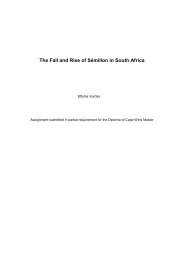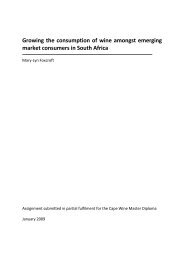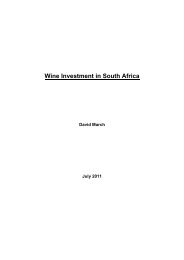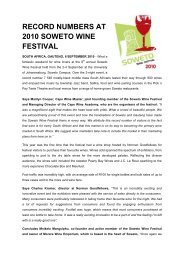micro-oxygenation in contemporary winemaking - Cape Wine ...
micro-oxygenation in contemporary winemaking - Cape Wine ...
micro-oxygenation in contemporary winemaking - Cape Wine ...
Create successful ePaper yourself
Turn your PDF publications into a flip-book with our unique Google optimized e-Paper software.
Micro-<strong>oxygenation</strong> <strong>in</strong> Contemporary W<strong>in</strong>emak<strong>in</strong>gneeds to be based on current best practice and tast<strong>in</strong>g panels need to be properlyconstituted and analysed correctly. Another significant problem <strong>in</strong> these studies is thetim<strong>in</strong>g of when the endpo<strong>in</strong>ts are evaluated. Significant differences that are foundimmediately after the <strong>micro</strong>-<strong>oxygenation</strong> treatment may not persist after subsequentoenological manipulation and maturation which means, <strong>in</strong> fact, that that impact of thetreatment on the f<strong>in</strong>al product delivered to the consumer is negligible.7.3 DESCRIPTION OF IDENTIFIED STUDIESThe key characteristics of the 19 English language scientific evaluations of <strong>micro</strong><strong>oxygenation</strong>I identified are summarised <strong>in</strong> Table 18. All of these studies were published <strong>in</strong>the last decade and there is clearly a rapidly grow<strong>in</strong>g literature on the subject s<strong>in</strong>ce morethan half of the articles were published <strong>in</strong> the last two years.A wide range of different grape varietals were used <strong>in</strong> the trials and this is certa<strong>in</strong> to<strong>in</strong>fluence the results obta<strong>in</strong>ed (Pérez-Magariño et al., 2009). It is encourag<strong>in</strong>g that two ofthe papers (du Toit et al., 2006a; de Beer et al., 2008) are from South African researchersus<strong>in</strong>g local varietals. All of the study designs <strong>in</strong>cluded a control w<strong>in</strong>e for comparison thoughthe nature of that control differed between studies. Earlier research tended to compareMOX-treated w<strong>in</strong>es aga<strong>in</strong>st untreated controls whereas the more recent <strong>in</strong>vestigationshave used more realistic comparison groups.The tim<strong>in</strong>g, dose and duration of <strong>micro</strong>-<strong>oxygenation</strong> employed was quite variable. Anumber of the <strong>in</strong>itial studies <strong>in</strong>vestigated MOX treatment after malolactic fermentation (postMLF) whereas, <strong>in</strong> keep<strong>in</strong>g with current practice, later <strong>in</strong>vestigations have used pre-MLFMOX, or treatments both before and after malolactic fermentation. Aga<strong>in</strong>, this variationmakes it extremely difficult to compare the f<strong>in</strong>d<strong>in</strong>gs of different studies.The vast majority of the identified studies focused on changes <strong>in</strong> colour and phenoliccomposition of treated w<strong>in</strong>es. There are only three reported studies which have<strong>in</strong>vestigated the effect on aroma compounds, three which measured w<strong>in</strong>e anti-oxidantstatus, and only one which has evaluated the impact on <strong>micro</strong>biological stability with anyrigour (Table 18). At present <strong>in</strong> the literature there are only five studies which havescientifically evaluated the impact of MOX us<strong>in</strong>g sensory panels. Most of the reportedstudies did have replicates and undertook some statistical analyses although this wasusually fairly limited.60
















